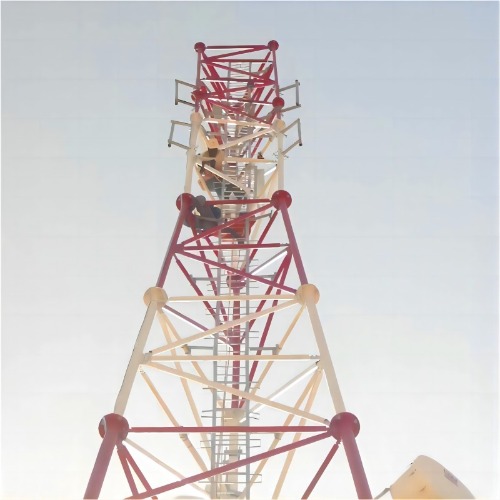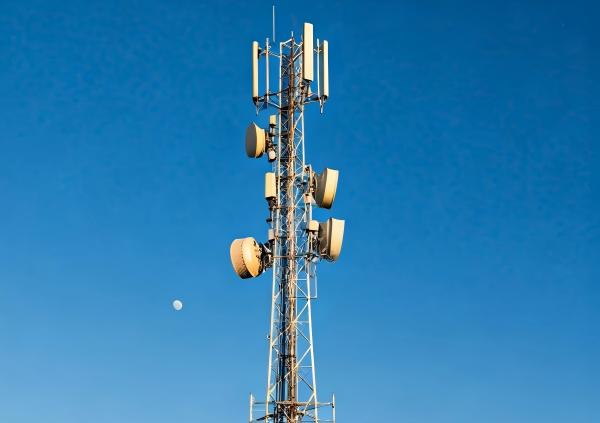Les tours de communication de grande hauteur font face à un ennemi invisible : vibrations induites par le vent À mesure que les tours s'élèvent pour accueillir les antennes 5G/6G, leurs fréquences vibratoires naturelles s'alignent davantage sur les fréquences d'excitation du vent, déclenchant une résonance qui amplifie les contraintes de 200 à 400 %. Les tours en treillis traditionnelles compensent ce phénomène par leur masse, mais en zone montagneuse ou côtière, cette approche devient coûteuse et peu pratique sur le plan logistique. Tour tubulaire en acier à 3 pieds : une solution élégamment conçue qui transforme la géométrie structurelle en une arme de conquête du vent.

La tour tubulaire à 3 pieds en instance de brevet (CN 221942102 U) comprend trois éléments clés :
Cadre de base triangulaire :Trois colonnes de support disposées en triangle équilatéral, créant une rigidité en torsion inhérente.
Enracinement variable :La base s'élargit à des hauteurs plus basses (par exemple, espacement de 10 m) et se rétrécit vers le haut, optimisant ainsi la répartition de la charge.
Contreventement auxiliaire :Cadres diagonaux reliant des colonnes adjacentes à intervalles réguliers, formant des « anneaux de rigidité » localisés (Figure 1).
Période de vibration naturelle réduite :Les cadres auxiliaires abaissent la fréquence naturelle de la tour de 2,5 à 3,0 s (treillis traditionnel) à 1,2 à 1,8 s, l'éloignant ainsi des plages de résonance du vent dangereuses (0,8 à 2,0 s).
Diffusion du stress :Le contreventement diagonal redistribue les forces de cisaillement du vent sur plusieurs nœuds, réduisant ainsi la contrainte maximale aux joints de 35 %.
La force de vibration induite par le vent est la suivante :
F_w = β \cdot \frac{1}{2} \rho v^2 \cdot A
Où:
β = Coefficient de vibration du vent (plus c'est bas, mieux c'est)
ρ = Densité de l'air
v = Vitesse du vent
UN = T surface utile
Les tours tubulaires 3-eg réduisent le β de 40 % par deux mécanismes :
1. Perturbation du vortex :Les colonnes triangulaires brisent les tourbillons de vent cohérents.
2. Oscillation amortie :Les cadres auxiliaires absorbent l'énergie cinétique via le micro-rendement.
Une simulation comparant une tour tri-tube de 45 m à une tour en treillis dans la zone des typhons du Fujian (vents de 55 m/s) a révélé :
1. Coefficient de vibration du vent : β = 1,25 (tri-tube) contre 2,10 (réseau)
2. Stress maximal : 182 MPa contre 291 MPa
3. Économies de matériaux : 28 % d'acier en moins requis

Une tour tubulaire à 3 pieds déployée à la frontière de Yuan en Chine (terrain : rocheux, vent moyen 30 m/s) a réalisé :
| Métrique | Tour à trois tubes | Tour traditionnelle |
|---|---|---|
| Coût des fondations | 18 000 $ | 35 000 $ (piles plus profondes) |
| Tonnage d'acier | 12,5 tonnes | 17,2 tonnes |
| Temps d'installation | 8 jours | 15 jours |
| Économies totales | 42% | — |
Simplicité de la Fondation :Moment de renversement 30 % inférieur → des fondations peu profondes suffisent sur un terrain rocheux.
Efficacité des transports :Les sections modulaires s'adaptent aux camions standards (aucune grue de levage lourde n'est nécessaire).
Zones montagneuses :Les cadres auxiliaires sont ancrés au substrat rocheux via des boulons d'ancrage, résistant à la torsion induite par les glissements de terrain.
Sites côtiers : L'acier galvanisé à chaud (86 μm) + les nanorevêtements en graphène combattent la corrosion saline 3 fois plus longtemps que la peinture.
Zones sismiques :La base triangulaire absorbe les ondes de cisaillement, réduisant le déplacement de 50 % par rapport aux réseaux carrés.
Les outils de conception générative (par exemple, la plate-forme BIM de National Energy Group) optimisent l'espacement des cadres auxiliaires pour les données éoliennes/sols spécifiques au site, réduisant ainsi le temps d'ingénierie de 60 %.
Capteurs intégrés :Les jauges de contrainte dans les cadres auxiliaires surveillent les contraintes en temps réel, prédisant la fatigue via l'IA.
Matériaux hybrides :Les renforts transversaux renforcés en fibre de carbone (en R&D) pourraient réduire le poids de 15 % supplémentaires.
28 % d'acier en moins → Réduction de 120 tonnes de CO₂ par tour.
Recyclabilité :La modularité tri-tube permet une réutilisation de 90 % des matériaux en fin de vie.
La tour tri-tube n'est pas seulement une mise à niveau structurelle, c'est un repenser fondamentalement la façon dont les tours luttent contre le vent Exploitant la physique des fermes triangulaires et un contreventement intelligent, il offre une résistance au vent sans précédent tout en réduisant les coûts et l'impact environnemental. Alors que la 6G exige des tours plus hautes sur des terrains plus difficiles, cette innovation deviendra l'épine dorsale de réseaux résilients et évolutifs.
À [TOUR DE L'ALTAI] , nous intégrons des conceptions tri-tubes avec la surveillance IoT et l'optimisation BIM pour fournir des tours qui résistent à la fureur de la nature. [Contactez-nous] pour concevoir votre prochain projet de haute stabilité !
